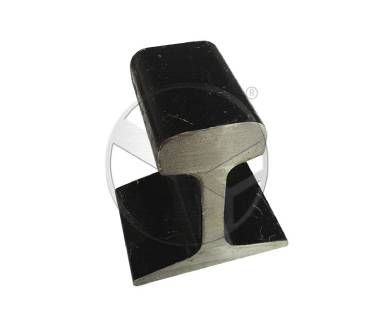Home >> News >> Latest News
Steel Rail is the main component of railway track. Its function is to guide the wheels of rolling stock to move forward, bear the huge pressure of the wheels, and transmit it to the sleepers. The rail must provide a continuous, smooth and least resistance rolling surface for the wheels. In the electrified railway or automatic block section, the rail can also be used as a track circuit.
Rail abrasion mainly refers to the side abrasion and wave abrasion of the rail on a small radius curve. As for the vertical wear, it is normal under normal circumstances, and increases with the increase of the axle load and the total passing weight. Improper setting of the track geometry will speed up the vertical wear rate. This is to be prevented and can be solved by adjusting the track geometry.

Steel Rail
Side wear occurs on the outer strand rails with a small radius curve, and it is one of the main types of damage on the curve now. When the train is running on a curve, the friction and slippage of the wheel and rail are the root causes of the side wear of the outer rail. When the train passes through a curve with a small radius, two-point contact between the wheel and the rail usually occurs, and the maximum side wear occurs at this time. The size of side wear can be expressed by the product of the lead force and the impact angle, that is, the wear factor. Improve the conditions for the train to pass the curve, such as the use of wear-type wheel treads, the use of radial bogies, etc., will reduce the rate of side wear.
From the perspective of public works, the material of steel rails should be improved, and wear-resistant rails should be used. For example, the wear resistance of high-hard rare earth rails is about twice that of ordinary rails, and hardened rails are more than 1 times.
Strengthening maintenance, setting appropriate gauge, outer rail superelevation and rail bottom slope, increasing the flexibility of the line, oiling the side of the rail, etc., can reduce the effect of side wear.
Wave-shaped wear refers to the wave-shaped uneven wear on the top surface of the rail, which is essentially wave-shaped crushing. Corrugation can cause high wheel-rail dynamics, accelerate the damage of rolling stock and track components, and increase maintenance and repair costs; in addition, the severe vibration of the train will make passengers uncomfortable, and in severe cases, it will also threaten driving safety; corrugation is also noise origin of. Serious disturbances have occurred on some freight trunk lines in our country. Its development speed is faster than that of side grinding, which has become the main reason for rail change.
Corrugations mainly appear on heavy-duty transportation lines, especially the coal and mine lines, which are particularly serious. They also occur to varying degrees on high-speed and high-passenger lines, and are more common on urban subways. On railways with higher train speeds, ripple abrasion mainly occurs, and it mainly occurs in straight and braking sections. Wave abrasion mainly occurs on heavy-duty transportation lines with lower speeds, and generally occurs in curved sections. There are many factors influencing the development of rail corrugation, involving many aspects such as rail material, line and rolling stock conditions. Countries all over the world are working on theoretical research on the causes of rail wave wear. There are dozens of theories about the cause of corrugation, which can be roughly divided into two categories: dynamic cause theory and non-dynamic cause theory. In general, the dynamic effect is the external cause of the corrugation of the rail, and the material performance of the rail is the internal cause of the corrugation. In fact, it is quite difficult to summarize all the causes of rail corrugation by analyzing only one aspect. It is necessary to take the vehicle and the track as a system to study the formation of multiple vibrations, and to conduct multi-faceted and multi-disciplinary research on the whole. In order to grasp the full picture of the causes of corrugation.
Grinding Rails is the most effective measure to eliminate corrugation. In addition, the following measures can slow down the development of corrugation: use continuous welding to eliminate rail joints and improve the smoothness of the track; improve the rail material to use high-strength wear-resistant rails, improve the quality of heat treatment processes, and eliminate the residual stress of the rail; improve the quality of the track , Improve track elasticity, and make the vertical and horizontal elasticity continuous and uniform; keep the curve direction round and smooth, the super height setting is reasonable, the outer rail working side is oiled; the wheel-rail system should have sufficient resistance, etc.
The allowable wear limit of the rail head is mainly determined by the strength and construction conditions. That is, when the rail wear reaches the allowable limit, one is to ensure that the rail has sufficient strength and flexural rigidity; the other is to ensure that the wheel flange does not collide with the joint splint under the most unfavorable conditions. In the "Rules for Railway Line Maintenance", the rail heads are divided into two categories, light injuries and severe injuries, according to the degree of wear and tear of rail heads. The corrugated rail is light-damaged rail if the valley depth exceeds 0.5mm.
The company also provides light rails and Heavy Rails, please feel free to contact us if necessary

Leave a message